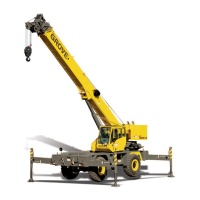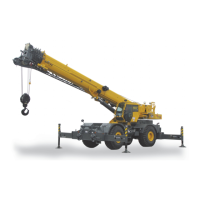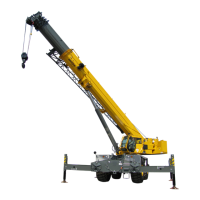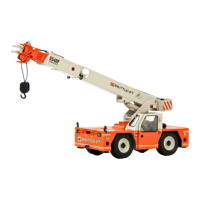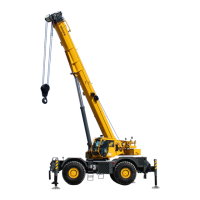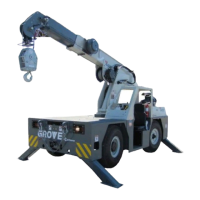Published 4-20-2015, Control # 502-01 2-19
RT540E SERVICE MANUAL HYDRAULIC SYSTEM
NOTE: Procedures A through H in the following text
correlate with Figures 2-6 through 2-10.
Procedure A - Checking/Setting the Main
Control Valve for Hoist(s), Boom Lift and
Piston Pump
NOTE: Procedure A for max. and P settings.
Set hoist(s) and boom lift as follows:
1. Install pressure check diagnostic quick disconnect with
gauge onto test nipple @ the GP2 Port of the accessory
manifold with swing directional control valve
(Figure 2-9).
2. Assure piston pump cut-off max.(Figure 2-13) factory
setting is correct. Loosen the jam nut on the cut-off max
adjusting screw and turn it in until it softly seats or
bottoms out. Then back the adjusting screw out 1/4 to 1/
2 turn and lock in place with jam nut. This will ensure that
full system pressure of 27.6 MPa (4000 psi) can be
obtained in step #4.
3. Assure piston pump
ΔP (stand-by) factory setting is
correct. With diagnostic quick disconnect still installed @
the GP2 port of the accessory manifold with swing
directional control valve (Figure 2-9), start engine and @
idle RPM adjust the piston pump differential setting
screw “in” to increase or “out” to decrease so that a
gauge reading of 2.2 - 2.8 MPa (325 - 400 psi)
(Figure 2-13). For CE machines, this pressure is 3.6-3.8
MPa (525-550 psi)
4. If the lift cylinder is not installed, plug the extend hose
(the larger of the two). If lift cylinder is installed, omit this
step and continue to step #5.
5. With diagnostic quick disconnect still installed @ the
GP2 port of the accessory manifold with swing
directional control valve (Figure 2-9), start engine and
throttle up to full RPM. Feather into the boom lift
controller to full controller stroke (up or down) and hold.
If the boom is installed, boom up to max elevation and
hold or boom down to minimum elevation and hold.
Adjust the load sense relief valve “in” to increase or “out”
to decrease so that a gauge pressure reading of 27.6±
0.4 MPa (4000 ± 50 psi) is achieved (Figure 2-10).
6. Stop engine and remove the diagnostic couplers from
the test nipples
Set telescope extend and retract as follows:
Extend
7. If boom is not installed, install a pressure check
diagnostic quick disconnect with gauge onto test nipple
@ the GP7 port of the main directional control valve
(Figure 2-10).
8. Cap hose (the larger of the two) running from port A,
telescope section of the main directional control valve to
the cylinder port block at the back of the base section.
9. Start engine and throttle up to full RPM. Attempt to
telescope OUT by feathering into the controller to full
controller stroke. Adjust the work port relief “in” to
increase or “out” to decrease so that a gauge pressure
of 24.2 ±0.4 MPa (2700 ±50 psi) is achieved
(Figure 2-10).
10. If the boom is installed, start engine and throttle up to full
RPM. Telescope out to fully extend the boom and hold.
Adjust the work port relief valve “in” to increase or “out”
to decrease so that a gauge pressure reading of 24.2
±0.4 MPa (2700 ±50 psi) is achieved (Figure 2-10).
11. Stop engine and remove pressure gauge and re-connect
plumbing.
Retract
12. If the boom is not installed, install a pressure check
diagnostic quick disconnect with gauge onto test nipple
@ the GP7 port of the main directional control valve
(Figure 2-10).
13. Cap hose (the smaller of the two) running from port B,
telescope section of the main directional control valve to
the cylinder port block at the back of the base section.
14. Start engine and throttle up to full RPM. Attempt to
telescope IN by feathering into the controller to full
controller stroke. Adjust the work port relief valve “in” to
increase or “out” to decrease so that a gauge pressure
reading of 22.5 ±0.4 MPa (3000 ±50 psi) is achieved
(Figure 2-10).
15. If the boom is installed, start engine and throttle up to full
RPM. Telescope in to fully retract the boom and hold.
Adjust the work port relief valve “in” to increase or “out”
to decrease so that a gauge pressure reading of 22.5
±0.4 MPa (3000 ±50 psi) is achieved (Figure 2-10).
16. Stop the engine and remove pressure gauge and re-
connect plumbing.
Procedure B - Setting The Outrigger/Rear
Steer/Oil Cooler Motor Pressures
1. Install a pressure check diagnostic quick disconnect with
gauge onto test nipple at G2 port of the outrigger control
manifold (Figure 2-11).
2. Start engine and throttle up to full RPM. Select and
activate the outrigger “extend or retract” switch on the
cab dash. Adjust the pressure reducing valve integrated
in the outrigger control manifold “in” to increase or “out”
to decrease so that a gauge pressure of 17.3 MPa ± 0.4
(2500 ±50 PSI) is achieved (Figure 2-11).
3. Stop engine. Remove the diagnostic coupler.
Reference Only

